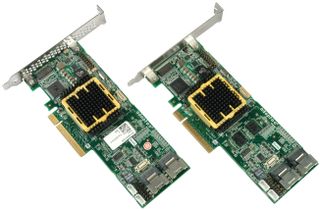Breaking Records With SSDs: 16 Intel X25-Es Do 2.2 GB/s
Controllers And Setup: Adaptec RAID 5805

Adaptec’s state-of-the-art Unified Serial host adapter product line is called the 5-series. There are many different models, each tailored to different internal/external storage requirements, such as low profile versus full-height cards as well as various port counts. Model 5805 is a low profile, eight-port internal SAS/SATA card.
Adaptec currently offers up to 28 ports on a single card. However, we deliberately went after two eight-port cards instead of one card with a massive number of ports so we could distribute the bandwidth across two PCI Express slots. If you look at the typical SAS/SATA HBA interface, you’ll find that it’s a first-gen x8 PCI Express connection, which reaches a maximum of 2 GB/s. Since we wanted to reach higher throughput, we had to go for two cards and create a software RAID array using the operating system.
We looked at the 5-series by Adaptec more than a year ago, but it’s still a top notch product line. The latest upgrade to the famnily was the 5Z-series, which introduces Adaptec’s Zero Maintenance Cache protection. Conventional RAID controllers come with a cache memory, typically ECC DRAM, and an optional battery backup unit, which maintains the cache content in the case of a power failure. Adaptec’s approach integrates flash memory with the controllers, saving the DRAM cache content into non-volatile flash memory.

System Details and Device Configuration
We decided not to assemble a purpose-built system for this project, since we wanted the 16-drive flash SSD array to be suitable to any upper-mainstream system, such as our Storage Reference Test System. Hence the test environment consisted of a Core i7-920 (2.66 GHz) on a Supermicro X8SAX motherboard, 3 GB of Corsair CM3X1024 DDR3 memory, and an OCZ EliteXstream 800W power supply.
The only change we had to make to the reference system configuration was the graphics card. The Radeon HD 3450 had to go away, as it utilized a PCI Express slot we needed for the RAID controller. The replacement was an old GeForce 4 MX 440 with 128 MB of memory and a PCI interface.
Stay on the Cutting Edge
Join the experts who read Tom's Hardware for the inside track on enthusiast PC tech news — and have for over 25 years. We'll send breaking news and in-depth reviews of CPUs, GPUs, AI, maker hardware and more straight to your inbox.
Current page: Controllers And Setup: Adaptec RAID 5805
Prev Page Drives: Intel X25-E 64 GB SSD Next Page Array Creation, Part 1: The Controller LevelMost Popular

